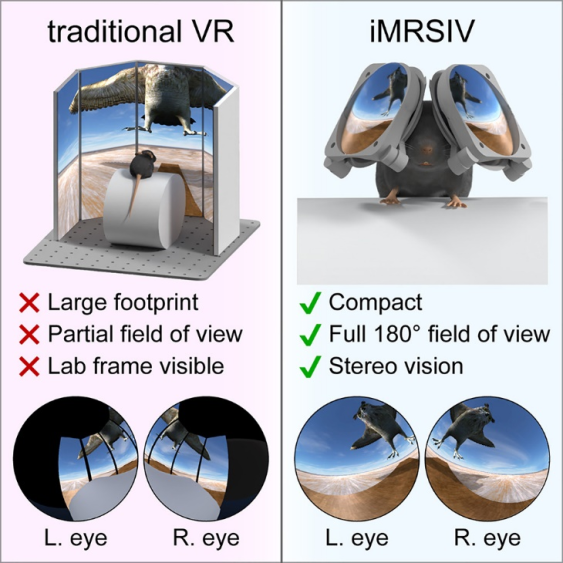Without mice, our current understanding of science would be a far-off dream. Monumental breakthroughs such as the polio vaccine, understanding of how neurons communicate, and any number of cancer treatment trials would be impossible without mice.
In the U.S. alone, 111 million mice and rats are used annually for biomedical research. A fact that has not gone unappreciated around the world. The humble lab mouse is honoured in Andrey Kharkevich’s ‘Monument to the laboratory mouse’ located in the Russian Academy of Sciences which depicts a mouse with pince-nez glasses knitting a double-helix of DNA (representing mice’s role in genetic research).

Andrey Kharkevich’s ‘Monument to the laboratory mouse’. Photograph: Qualte/ DeviantArt
With the immense hardship that mice have been put through over the years when you read the title ‘Full field-of-view virtual reality goggles for mice’ you would be forgiven for thinking that humankind has finally decided to make something fun for the species.
Unfortunately for the mice, this is only half-true.
Northwestern University Researchers have been observing mice brains using traditional VR for the past 15 years; observing their neural activity whilst navigating virtual environments and scenarios in order to map the underlying neural activity responsible for the observed behaviour.
An important element of attaining a clear brain scan is that the subject must remain relatively still. However, for mice (famously very active and wriggly creatures) this is an issue. This issue is compounded when researchers try to observe a mouse's brain whilst running, jumping or otherwise generally in motion. This is where the traditional projector or screen-style VR is utilised.
In this style, mice are secured on a treadmill and their virtual world is projected onto nearby screens. Whilst relatively effective, this setup allows the mouse to see outside of the projection and does not cover the full field of vision or allow depth perception. The difference is essentially the same as watching a horror movie on the big screen, compared to being thrust into the horror movie. Even for the bravest and most logical of folk, with an immersive enough VR experience, it can be very difficult for even humans to persuade their fear response that their perception is merely an illusion.
As such, it is more difficult to determine how much of the observed neural activity is in response to the projection compared to the outside world. Additionally, the equipment for neural scanning in traditional mouse VR takes up the space about the mouse’s head; therefore, removing the potential to incorporate overhead projections into the simulation.
The iMRSIV (Miniature Rodent Stereo Illumination VR) system, however, bypasses all these issues.

Visual abstract of the (2023) Pinke et al., study.
By creating a compact rig utilising two OLED screens capable of simulating depth perception, Northwestern University researchers have created the world’s first full FOV VR for rodents. But more than this, they have also allowed for the neural observation of mice experiencing overhead threats for the first time due to the goggles' compact size allowing for overhead equipment that traditional VR could not. An additional side effect of the greater immersion is a decrease in required training times for the rodents, potentially increasing the efficiency of future studies utilising iMRSIV.
Whilst the researchers note that improvements to mice VR immersion can be made (notably in possibly future technology allowing observation of free-roaming mice) the goggles are relatively cheap and user-friendly; opening the door for more labs to use the technology in future research.
So whilst this round of VR mice may not be the grand, fun-filled adventure that mice are owed, this new technology has cleared the path for more VR-based neural studies in rodents. Moreso, iMRSIV has also laid the foundations for the first VR gaming company with the sole purpose of transporting mice to their virtual paradise (like the matrix, but better).
To read the full paper see the below link:
https://doi.org/10.1016/j.neuron.2023.11.019
References:
Pinke, D., Issa, J. B., Dara, G. A., Dobos, G., & Dombeck, D. A. (2023). Full field-of-view virtual reality goggles for mice. Neuron. https://doi.org/10.1016/j.neuron.2023.11.019